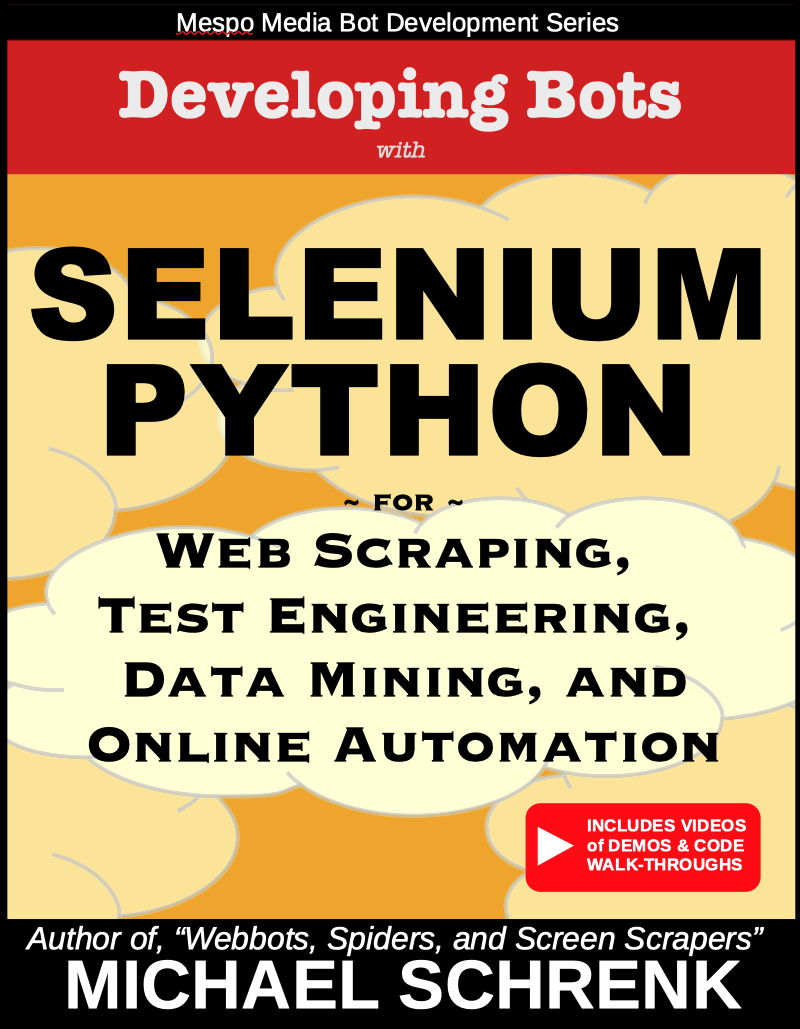| Chapter 01 |
Why Write a Bot?
Why write a bot? Good question...! Organizations of all types--ranging from Governments, Start-ups, to International News Agencies, have asked me to write
bots that: Gather Market Information, Automate Process, Manage Inventory, Analyze Data, and Buy Inventory. Bots have physically taken me from Moscow
to Silicon Valley. In other words, professional bot development can be a fine career choice.
|
| Chapter 04 |
Project 01 Hello World...!
In our first project, we develop a minimal Selenium Python program, primarily for the purposes of validating our development environment.
Link to Bot #01 Demo and Code Walk-through on YouTube
|
| Chapter 05 |
Project 02 The Framework
To make our work a little easier, going forward, this chapter explores the use of a "Framework", or a systematic way to ensure that
our bots are correctly initialized, have access to bot-specific libraries and logging functions, and exit gracefully.
Each bot going forward will use this framework.
Link to Bot #02 Demo and Code Walk-through on YouTube
|
| Chapter 06 |
Project 03 Active Content
One of the main attractions to Selenium is the way it manages active content, or web content that was downloaded from the webserver
after the initial page flow is Complete.
Link to Bot #03 Demo and Code Walk-through on YouTube
|
| Chapter 07 |
Project 04 Procurement
This project puts good use of a private "test" online store to train a bot to purchase two types of plastic cups from an Industrial supply house.
Bots like this could be tied into inventory and retail systemds to automate a large amout of retail management,
Link to Bot #04 Demo and Code Walk-through on YouTube
|
| Chapter 08 |
Project 05 Action Chains
The Selenium developers created a very clever way to script intricate mouse functions, like: Drag and Drop, Hover, Right Click, and more
in a package called Action Chains.
This project deploys Action Chains to control a variety of jQuery widgets.
Link to Bot #05 Demo and Code Walk-through on YouTube
|
| Chapter 09 |
Project 06 Parsing and Aggregation
This project simulates an experience that is very common to bot developers--that of, collecting data from disparate sources and
parse and combine all the data in a common CSV file for later transport,
Link to Bot #06 Demo and Code Walk-through on YouTube
|
| Chapter 10 |
Project 07 Regression Test
The most common use for Selenium is for Test Engineering. This project explores the methodology and usage for performing
Regression Tests on a multi-page, test, corporate website.
Link to Bot #07 Demo and Code Walk-through on YouTube
|
| Chapter 11 |
Project 08 Solving CAPTCHAs
In Project 08, the reader learns the legitimate reasons for writing bots that need to solve CAPTCHAs. We'll also learn
the techniques that are most often used for solving these challenges.
Link to Bot #08 Demo and Code Walk-through on YouTube
|
| Chapter 12 |
Project 09 Bots that play games
This bot autonomously plays Tic-Tak-Toe against an online game. In addition to game play, this project employs very explicit
logging, which will be used extensively in the next project.
Link to Bot #09 Demo and Code Walk-through on YouTube
|
| Chapter 13 |
Project 10 Headless Mode
In our final project, we'll leverage all the work we did in the last project (and the excellent logging) to demonstrate how
easy it is to run the game playing bot without a browser. We'll also unearth the advantages, and disadvantages, for running Selenium
without a browser.
Link to Bot #10 Demo and Code Walk-through on YouTube
|
| SECTION II Theory |
| Chapter 14 |
Staying out of jail
With freedom comes responsibility. And it's important to acknowledge that the same technologies that organizations invest in to
perform business functions, are also the same technologies and techniques that hackers use to cause harm. While this chapter
contains NO legal advice, it does contain what the Author has learned and been exposed to in over 25-years of bot development.
|
| Chapter 15 |
DOM and JavaScript
An understanding of Selenium requires an understanding of DOM, or the Document Object Model. This chapter explores DOM, its relationship
to JavaScript, and how it's used by Selenium.
|
| Chapter 16 |
Locators
Selenium uses a variety of ways to locate web elements on a web page, This chapter explores them all, with special focus on XPATH.
|
| Chapter 17 |
Webdriver
At the core of Selenium is Webdriver. We'll look at how Webdriver works and how it can emulate virtually any modern browser and
revision. This is particularly useful for test purposes.
|
| Chapter 18 |
Parsing Text and the semantic web
This chapter describes what the Author learned about parsing over 25 years of writing bots. Special attention is placed on the libParse.py
library.
|
| Chapter 20 |
Fault Tolerance
A happy bot is one that doesn't make mistakes. Read this chapter to avoid making beginner mistakes.
|
| Chapter 21 |
Machines as humans
There are very legitimate reasons for making bots that are as stealthy and nondescript as possible. This chapter discloses those
reasons and ways to accomplish those goals.
|
| Chapter 20 |
Big data big headache
The public keeps hearing about the amazing things that can be accomplished with big data. What we don't hear is what a pain it is
to move large datasets. This chapter defines that pain and describes technologies to ease the agony.
|
| Chapter 23 |
Chrome Inspect
One of the reasons this book focuses on the Chromedriver flavor of Webdriver, is because Chrome Inspect is a very useful bot development
tool. This chapter shows the benefits of using Chrome Inspect in botDev.
|

